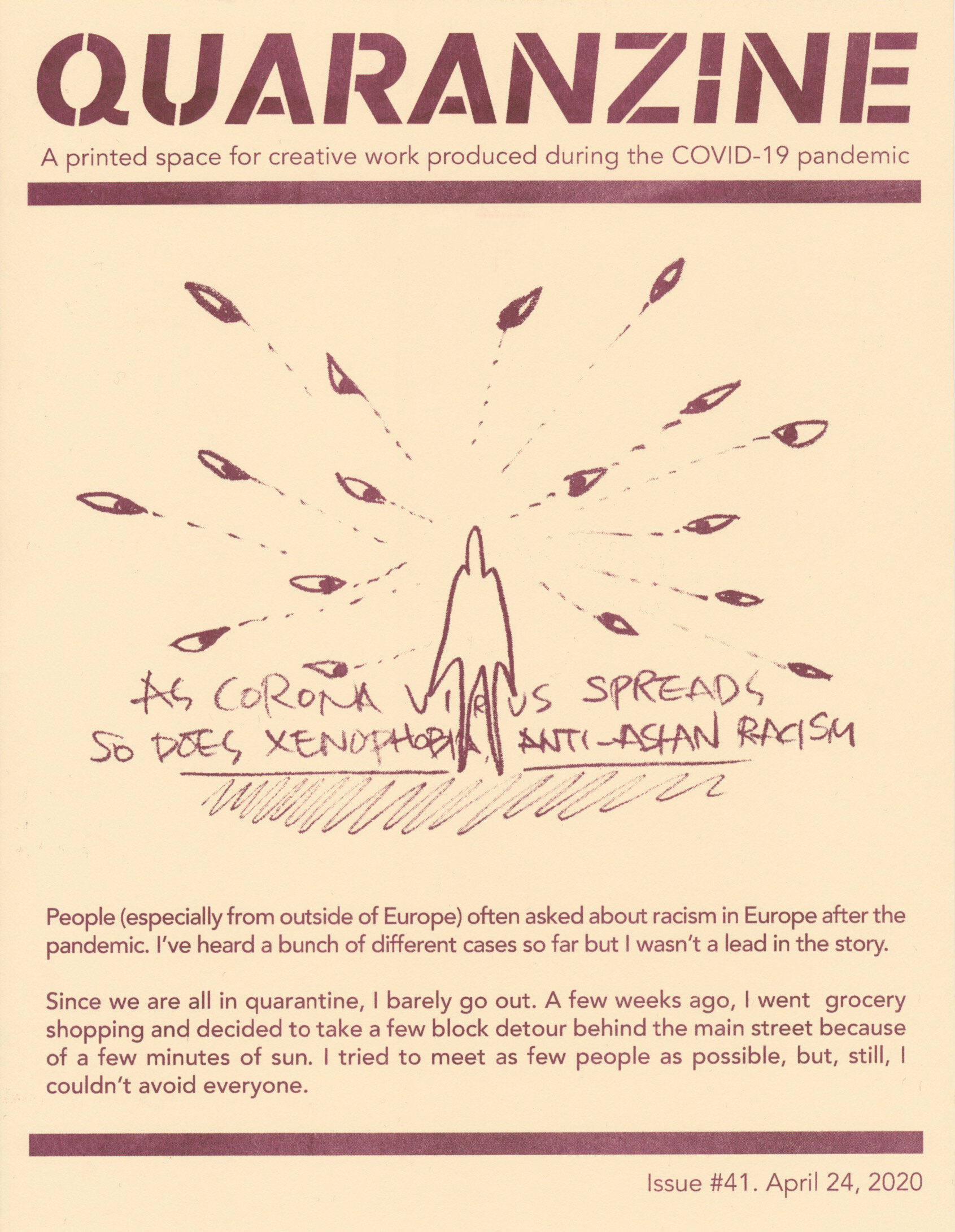100 Issues of Quaranzine / 3 months of Quarantine Times
06/17/20
By Marc Fischer
As Quarantine Times winds down, my project QUARANZINE, which I started on March 15th also nears its end, for now at least. QUARANZINE is a one-page zine published by my project Public Collectors that functions as a printed space for creative work produced during the COVID-19 pandemic. Nearly every issue has been a collaboration with another artist or writer. Each issue is a standard 8 ½ X 11 inch piece of paper printed on both sides using a Risograph duplicator. Finished issues are scanned and shared on social media, sent to the artist contributors, and sold in assortment packs to people who want to support the project and have physical copies. Eventually some complete sets will go into various libraries, archives, and other collections. I also post issues publicly, including a guerrilla exhibition at Parkview Park in my neighborhood (Avondale) where I rolled up 18 issues and shoved them through the gaps in a chain link fence for people to people to find, read, or take home. They disappeared in less than 24 hours. I have no idea where they went.
I have made an issue every day since March. When I miss a day, I make two issues on another day to catch up. When I last wrote for Quarantine Times I had just finished issue #10. Today I just finished issue #93. This has been an exhilarating way to work but not easy to sustain. I decided to stop at issue number 100.
Way back in issue #50 (which feels like it could have been last week, or a year ago, but was actually May 3rd), I wrote some reflections:
“A lot is being written about the changes people are having to make in the way they live because of the pandemic—like when you go to the doctor and they see the poor choices you’ve been making and tell you sternly, “You’re going to have to make some serious changes.” For me this project is a reinforcement of processes and practices that have always been sustainable. I’m still self-publishing like I’ve done for over thirty years; it’s just back to basics. I’m still collaborating with others—including people I’ve never met in person that send me their work. I’m still making a big project by building gradually over time rather than consuming massive resources to make something large from the start. QUARANZINE is intimate. It is not a spectacle. It is cheap to make and for others to support. It’s inclusive.
Collaborating, even during social distancing, means spending time with other people. Every day I spend a few hours emailing, designing, printing, and working in a way that shares time, thought, and emotion with others. We email back and forth until we like the way the issue looks and it’s time to print it on the Risograph in my basement. Once the issue is printed, I scan it and share the results and we get to celebrate that we made something together. Other people join the conversation online and discuss what we made.
Now is a time when a lot of artists are being forced to scale down in order to keep making things. They are playing concerts by themselves in their bedrooms and kitchens and broadcasting them over the internet. They are printing with tools like the inkjet or laser printer on their desk. They are making small drawings and sculptures and taking photos and writing. People aren’t consuming as much. They are looking at what they already have and saying, “I could make something edible with that weird ass combination of things in the pantry.” They are seeking knowledge from others, reading, and learning new skills. People I know that have never grown anything before are starting food gardens in their windowsills. People are also being gentle with themselves and taking it slow, which is a good idea. ”
The murder of George Floyd by Minneapolis police and the subsequent protests all over the world forced a massive shift in where many people were focusing their energy; it was natural that this project and Quarantine Times should flex in that moment too. In the days the followed, drawings of masks and rants about grocery shopping experiences in QUARANZINE felt a lot less necessary. Some QUARANZINE artists changed the direction of their contributions. Unexpected collaborations happened as people who may not have needed to vent about the virus, had a great deal to say about their experiences of racism and police intimidation. A musician friend from high school, Shawn Cephas—normally one of the most chill people I know—wrote a scathing letter to White amerikkka. Alexander Richard Wilson, who originally submitted drawings for consideration, instead allowed his written account of the May 30th protests in downtown Chicago to be the focus of his issue. Other people did what they might have done on any other day of the pandemic and that was okay too. We have many extremely challenging things happening simultaneously.
Both QUARANZINE and Quarantine Times rushed into action quickly and created space for dozens of voices. People should understand, however, how extremely informal these very substantial projects are. I’ve had no contracts to sign; I’ve sent no contracts to be signed. Boring bureaucratic formalities don’t drive this kind of work; love and trust and shared values and creative commitments are what sets projects like this into motion.
Where Quarantine Times and QUARANZINE differed is that the former maintained a strictly Chicago focus, whereas my daily zine included contributors from all over the country as well as overseas. Some people like Liz Mason at Quimby’s Books contributed to both projects. Everything was developed and edited on short notice but the writers for Quarantine Times really deserve extra high praise for springing into action and crafting longer pieces with much more firm deadlines. Oscar Arriola was out taking photos in the Loop the day after the rebellion that swept down and beyond Michigan Avenue, and had to edit those images into a portfolio with me with little time to spare. Eric Von Haynes was actively printing protest posters for events at the same time that he was writing about what doing this work meant. In the days since Nell Taylor of Read/Write Library contributed, she could write an entirely different piece now that her library is being used as a food and supply collection and distribution hub in a partnership with Brave Space Alliance. Frank Chapman wrote a call to protest over COVID-19 in Cook County Jail. In the days since his article, his major work of pushing for CPAC (Civilian Police Accountability Council) is suddenly a widely discussed national concern as people in cities everywhere push to defund and disband their police departments. Tara Betts wrote a beautiful essay about the film Atlantique and the Black and Brown bodies that are particularly vulnerable during the pandemic. Now she’s in the midst of a just days old GoFundMe campaign to raise money to buy a building and create a community space on the South Side called The Whirlwind Center.
Quarantine Times and QUARANZINE have been forceful reminders of what we have, and the potential for what we can do with these resources. At the very least, we have each other, and all we have to do is make time to see what we can produce together. Every person in your life is a potential collaborator if you create a structure that makes space for their knowledge and experiences. If we have trust, confidence in other people, and a belief that we can start and finish things together under atrocious conditions, people will do the best work that they can and we’ll make great things. And when it doesn’t work because someone just couldn’t, or I couldn’t when I thought I could, it has been important to go easy on ourselves.
In a collaboration, everyone has a stake in the thing that is being made so there is a place for feedback and editing and suggestions and alterations, and a selection process. Moving through that process so quickly when it’s not how you are used to creating is a little intense at times, but it has worked astonishingly well in these projects.
I don’t know when I will do QUARANZINE again, or if I will do something like it again. 100 issues in 100 days and playing editor for nine Quarantine Times contributors was not how I thought I would spend the first hundred days of my pandemic. I do know that if I decide to pick up QUARANZINE again, it will just feel like a little stroll around the neighborhood rather than a marathon, and I hope my community will be there again to take that walk with me.











